Indiana is located in the Midwestern region of the United States, which means it experiences diverse weather conditions throughout the year, including snowstorms during the winter months. Snowstorms are common in Indiana, and the state has experienced many significant snowstorms.
One of the most notable snowstorms in recent history in Indiana took place from March 19th to 20th, 1906, all over significant parts of Indianapolis and surrounding areas. This event brought over 12.3 inches of snow to the state, accompanied by high winds and subzero temperatures. The storm’s severity resulted in a near-complete shutdown of the state’s operations for several days.
This article will delve into the nature of the snowstorm, its effects on residents and wildlife alike, and other essential points. Let’s get into it.
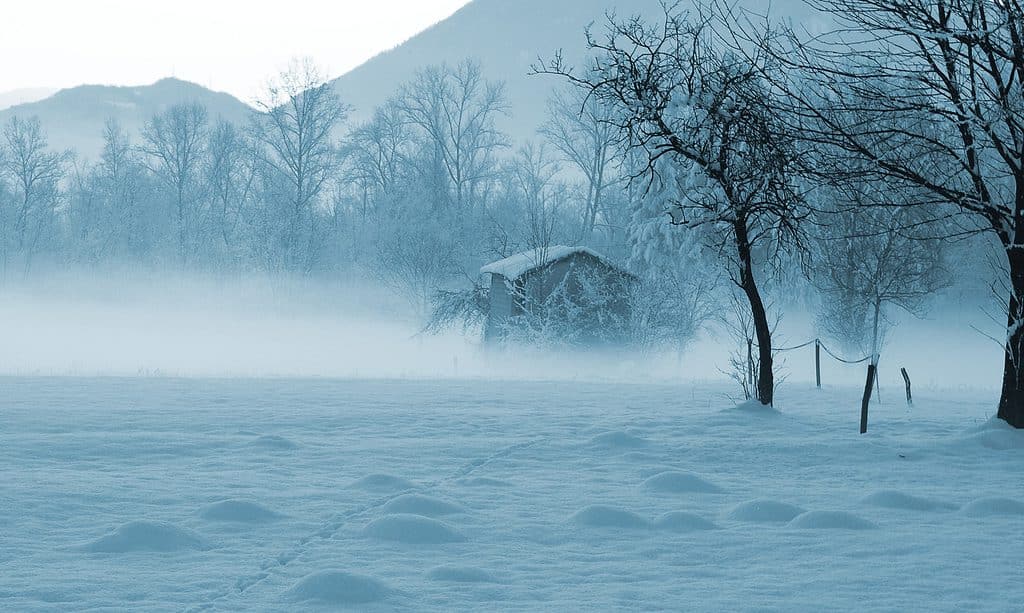
Snowstorms are common in Indiana, and the state has experienced many significant snowstorms.
©iStock.com/corradobarattaphotos
What is the Typical Weather for the State of Indiana During March?
In March, Indiana transitions from winter to spring, making the weather somewhat unpredictable. Some days can be cold, while others feel like spring has arrived. The temperature on this month usually ranges from the mid-30s°F (1-2°C) in the northern part of the state to the mid-40s°F (6-7°C) in the southern part of the state.
It tends to rain quite a bit in March in Indiana, with an average precipitation amount of 3-4 inches (76-102 mm) statewide. Sometimes, it can also snow, especially in the northern part of the state. The southern part of the state often rains more than it snows.
March is a transitional month that experiences a variety of precipitation types due to the changing weather patterns. Precipitation is any form of water that falls from the atmosphere to the ground, including rain, snow, sleet, and freezing rain.
Indiana typically experiences a mix of precipitation types, including rain, snow, and a combination of both. The kind of precipitation depends on several factors, such as temperature, humidity, and air pressure.
Rainfall is a common type of precipitation in Indiana in March, particularly towards the latter half of the month when temperatures start to warm up. Rain is liquid water that falls from the sky and is formed when water vapor in the atmosphere condenses and falls to the ground.
Indiana can also experience snow in March, particularly during the early part of the month when temperatures are colder. Snow is formed when water vapor in the atmosphere condenses directly into ice crystals, which then fall to the ground.
March in Indiana can be a bit wild with severe weather, such as thunderstorms and even tornadoes. However, the frequency and intensity of these events are inconsistent from year to year. So, it’s wise to be prepared for all weather conditions. Checking the weather forecast frequently and dressing appropriately in layers can make a big difference in keeping you comfortable and safe throughout the day.
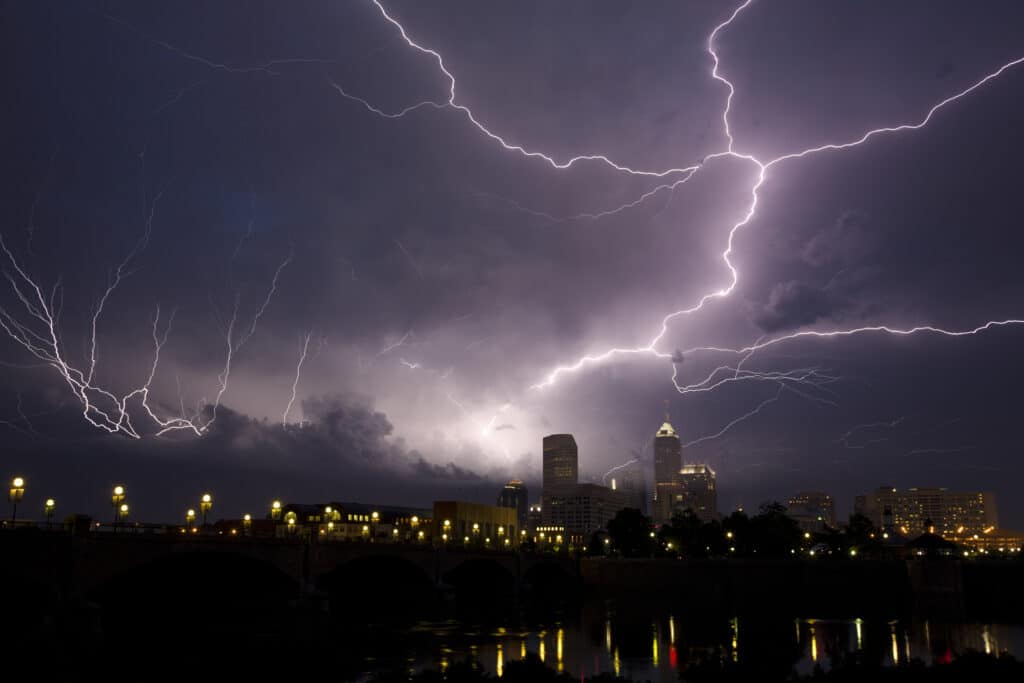
March in Indiana can be a bit wild with severe weather, such as thunderstorms and even tornadoes.
©iStock.com/alexeys
What was the Biggest Snowstorm to Ever Hit Indiana During March?
On March 19th and 20th, 1906, Indiana experienced one of the largest snowstorms ever to hit the state during this month. The storm was part of a broader system that affected the Midwest and Northeast regions of the United States.
The snowstorm dumped several feet of snow in many areas of Indiana, with some locations receiving up to 12.3 inches of snowfall. This amount of snow made it difficult for residents to move around or carry out daily activities, and it also caused significant damage to buildings, power lines, and transportation systems.
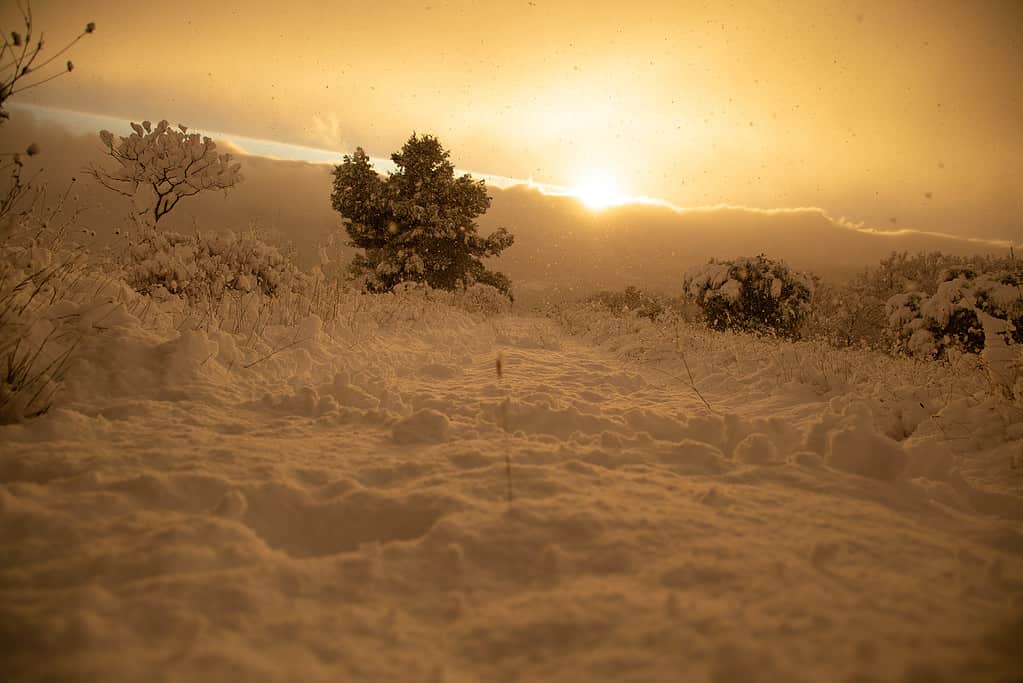
On March 19th and 20th, 1906, Indiana experienced one of the largest snowstorms ever to hit the state during this month.
©Callan Verdon/Shutterstock.com
How Did the Snowstorm Affect Residents Living in the State?
The most severe snowstorm to ever hit Indiana in March was a historical event that left residents of the state reeling from its effects. The storm, from March 19th to 20th, 1906, brought high winds and heavy snowfall throughout much of the state.
Many areas were left without power or access to necessities such as food and water for days after the storm had passed. Furthermore, some roads were blocked by fallen trees or deep snow accumulations, making travel difficult for those who needed it. This devastating winter weather event impacted many Indiana residents both directly and indirectly. Here’s a detailed account of how the snowstorm affected Indiana residents.

Many areas were left without power or access to necessities such as food and water for days after the storm had passed.
©Fboudrias/Shutterstock.com
Transportation
Transportation was one of the most affected areas during the storm in Indiana. The heavy snowfall and high winds made roads impassable, leaving many people stranded in their homes. Public transportation systems such as buses and trains were also halted, causing further disruption to travel plans.
The storm also had a significant impact on the trucking industry. Trucks are crucial for transporting goods all around the state, but with the roads covered in snow and ice, it was tough for them to drive safely. This meant there were delays in getting important supplies and goods to where they needed them.
Agriculture
Agriculture in Indiana was another industry severely impacted by the storm. Many farmers experienced extensive crop damage due to the weight of the snow and ice, which broke tree branches, destroyed crops, and damaged irrigation systems.
Livestock farmers also faced challenges as the snow and freezing temperatures made providing food and water for their animals difficult. The transportation disruptions caused by the snowstorm hindered the timely delivery of feed, fertilizers, and other farm supplies, further complicating the situation.
Property Damage
The weight of the snow caused many roofs to collapse, and fallen trees and power lines caused damage to homes and buildings. Some residents also experienced flooding due to snow and melting ice.
The weight of heavy snow and ice on roofs, trees, and power lines led to many collapses and breakages. Buildings, garages, and barns suffered damage to their roofs, walls, and foundations, and some were utterly destroyed. Homeowners had to deal with burst pipes, flooding, and water damage caused by melting snow and ice seeping through roofs and walls.
Vehicles were not spared, as some got stuck or damaged while driving on the slippery, snow-covered roads.
Mental Health
The storm’s severity likely elicited fear and anxiety among Indiana residents. Particularly affecting those in vulnerable situations, such as the elderly or those with pre-existing mental health conditions.
The storm also forced residents to stay indoors and limit their activities, which may have led to a sense of isolation and helplessness. Prolonged isolation can be detrimental to mental health and may result in feelings of boredom, loneliness, and cabin fever.
Furthermore, the financial burden of storm-related damages and lost wages could have heightened stress and anxiety among residents. Particularly causing stress for those already experiencing financial difficulties. Disruption to daily routines and uncertainty regarding the duration of the storm may have also contributed to feelings of frustration and helplessness.
How Do Late-Season Snow Storms Impact Wildlife in the Area?
Late-season snowstorms can be tough on the wildlife in Indiana. When it gets cold and the snow piles up, animals struggle to find enough food and shelter to make it through. This is especially true for smaller animals like mice and shrews that find it challenging to get food when the snow is deep. This can cause problems for predators who depend on them for food too.
Even bigger animals like deer and elk can be affected by snowstorms. They may have trouble finding enough food and moving around when snow is on the ground. This can make them sick or even cause them to die in serious cases. And migrating birds might have to cancel their journey north because of the storm, which can mess up their nesting schedules.
Moreover, snowstorms can cause changes in animal behavior. Predators may have to adjust their hunting strategies, while prey animals may alter their habits to find food and shelter. Human activities can also worsen the impact of these storms on wildlife. Such as, limiting development and habitat destruction which give the ability to animals to survive in harsh weather conditions. Pollution and climate change can also contribute to more severe weather events, putting additional pressure on animal populations.

The storm can mess up their nesting schedules.
©iStock.com/Hongkun Wang
How Do Animals in Indiana Cope Amid a Snowstorm?
In the face of a snowstorm, animals in Indiana must overcome various challenges to survive. The cold, snowy weather and food scarcity can significantly threaten their well-being. Nevertheless, different species have adapted to the winter climate in unique ways.
Some hibernate to conserve energy, while others grow thicker fur to stay warm. Certain animals modify their foraging behavior, whereas others migrate to more hospitable environments. This section will delve into the strategies employed by different animals in Indiana to cope with snowstorms and thrive despite the harsh winter conditions.
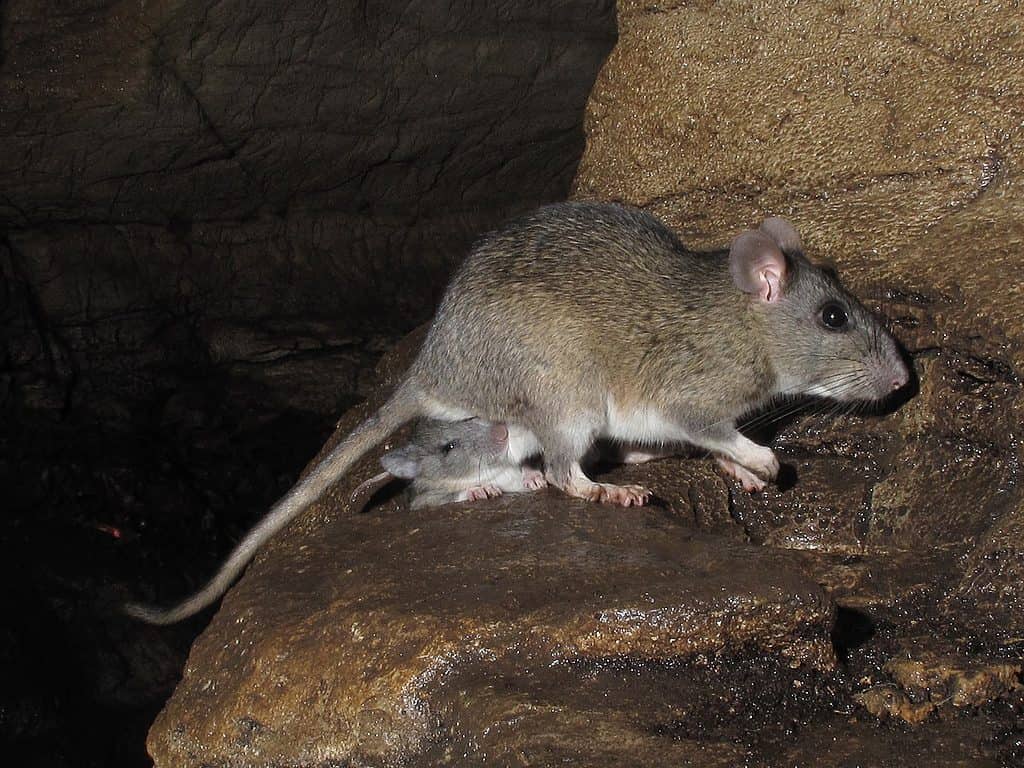
The woodrat’s body temperature and metabolic rate decrease during extreme cold or food scarcity periods.
©Alan Cressler / CC BY-SA 2.0 – License
Allegheny Woodrat
The woodrat has physical adaptations that help it to cope with snowstorms. Its long, bushy tail provides insulation and helps to maintain balance while moving through deep snow. The woodrat’s large, dark eyes are adapted for low-light conditions, enabling it to forage for food even in the dim light of a winter day.
Another adaptation of the Allegheny woodrat is its ability to go into torpor. Torpor is a state of reduced metabolic activity similar to hibernation. The woodrat’s body temperature and metabolic rate decrease during extreme cold or food scarcity periods. This enables it to conserve energy and survive until conditions improve.
Badger
Badgers have developed several adaptations to cope with the challenges of snowstorms and other harsh winter weather conditions.
One of the primary ways badgers cope with snowstorms is by seeking shelter in their underground burrows. These burrows provide insulation from the cold and protection from the elements. Badgers build their burrows with multiple entrances and exits. These allow them to move in and out even if one entrance is blocked by snow.
Badgers also have physical adaptations that enable them to survive in snowy conditions. Their thick fur helps to keep them warm, while their long claws allow them to dig through snow and ice to access food or create new burrows if necessary.
Beaver
Beavers have physical adaptations that allow them to survive in snowy conditions. For example, their fur is specially designed to trap air close to their skin, which provides insulation and keeps them warm in cold weather. They also have webbed hind feet, which they use to move around their lodges and dams in the snow.
Beavers have another adaptation that allows them to store food for the winter months. They construct food caches near their lodges, consisting of tree bark, twigs, and other vegetation. This ensures they have access to food even when it might otherwise be scarce.
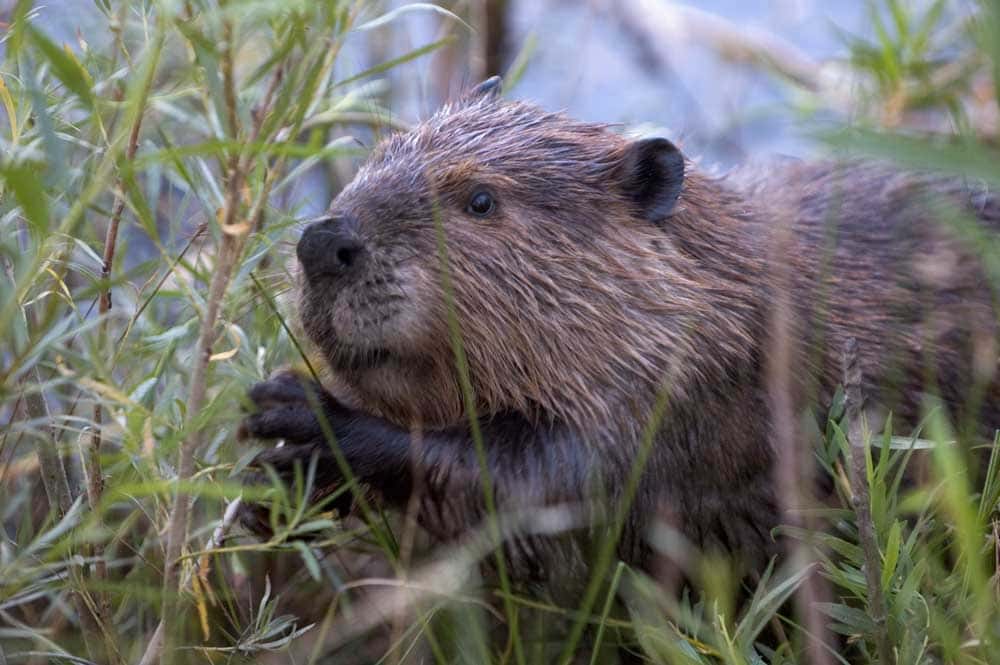
Beavers construct food caches near their lodges, consisting of tree bark, twigs, and other vegetation.
©No machine-readable author provided. Cszmurlo assumed (based on copyright claims), CC BY-SA 3.0, via Wikimedia Commons – License
Black Bear
Black bears are remarkable creatures. They have developed several strategies to cope with the challenges of snowstorms and other harsh winter weather conditions.
One of the primary ways black bears cope with snowstorms is by hibernating during winter. Hibernation allows them to conserve energy and avoid the worst snow and cold temperatures. While in hibernation, black bears enter a state of reduced metabolic activity, slowing down their heart rate, breathing rate, and body temperature to save energy.
However, if black bears venture out during a snowstorm, they have several adaptations that help them cope with the harsh conditions. For instance, they have thick fur that insulates them against the cold and repels moisture, keeping them dry and warm.
Bobcat
One of the ways that bobcats cope with snowstorms is by reducing their activity level and conserving energy. Amid snowstorms, bobcats may take shelter in dense vegetation, under rocks or ledges, or in dens, they have dug out themselves. By reducing their activity, they can conserve energy and minimize exposure to harsh weather conditions.
Bobcats also have thick, fluffy fur that insulates them against the cold. Their fur traps warm air close to their skin, providing excellent insulation to keep them warm and dry amid snowstorms. They also have fur on the bottoms of their paws that provides additional insulation and helps them walk on top of the snow.
Birds
Birds have various methods of coping with extreme weather. They adapt their behavior by huddling together for warmth and switching their diets to seeds and berries.
They also possess physical adaptations, such as specialized feathers that provide insulation and oil glands to repel water. Finding shelter is also essential; birds seek protected areas like thickets and birdhouses. Water is also vital; some birds will melt snow or ice to access it.
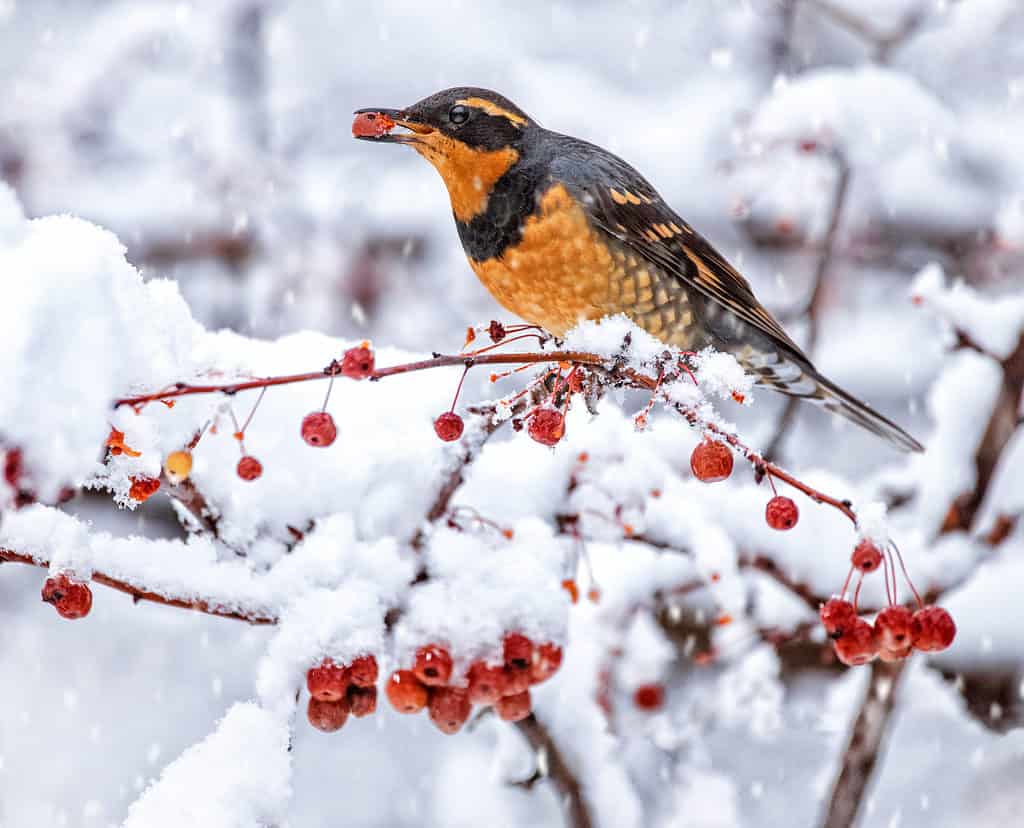
Many birds adapt their behavior by huddling together for warmth and switching their diets to seeds and berries.
©Annette Shaff/Shutterstock.com
Fish
Fish living in Indiana have developed unique ways of coping with harsh winter weather, including snowstorms. To survive, they adjust their behavior by seeking out warmer, more stable areas of lakes or moving closer to shore for shelter. They also possess physical adaptations like brown fat tissue, specialized gills, and the ability to tolerate low oxygen levels.
Finding food during winter can be challenging. Some species feed less frequently, relying on stored energy reserves, while others continue to feed on available prey.
Bottom Line
The biggest snowstorm in Indiana left a significant mark in the state’s history. It brought widespread disruptions, challenges, and even dangers to the residents, wildlife, and the environment. But amidst the snow-covered roads, power outages, and property damage, people showed resilience, kindness, and a sense of community.
Strangers helped each other shovel driveways, delivered supplies to the elderly, and shared warmth and comfort in makeshift shelters.
The snowstorm may have caused chaos and inconvenience, but it also revealed the best of human nature in times of crisis. As the snow melts and life slowly returns to normal, let us not forget the lessons we learned and the values we upheld during this challenging time. Let us continue to look out for each other, appreciate the beauty of nature, and be prepared for whatever the future holds.
The photo featured at the top of this post is © Susan B Sheldon/Shutterstock.com
Thank you for reading! Have some feedback for us? Contact the AZ Animals editorial team.






